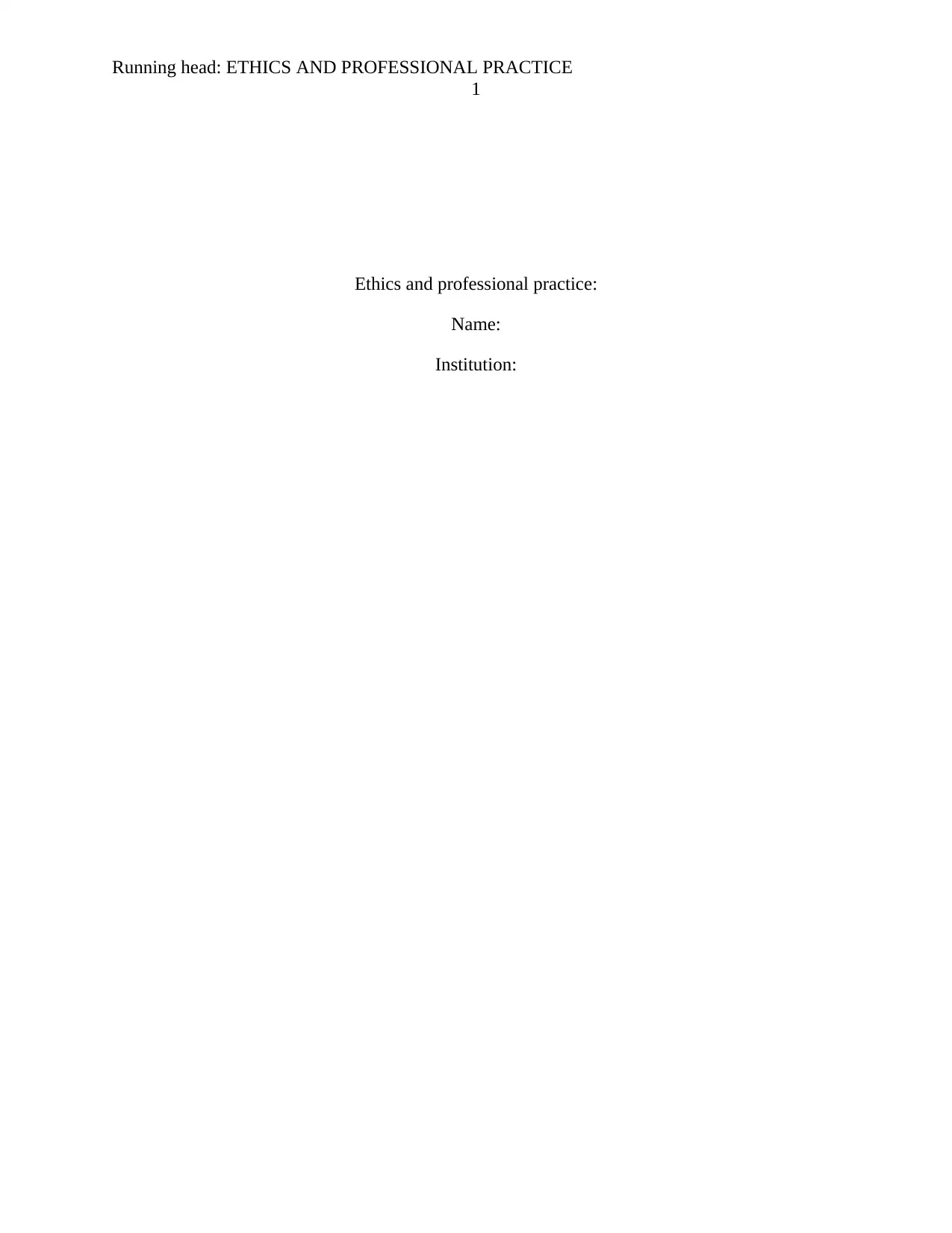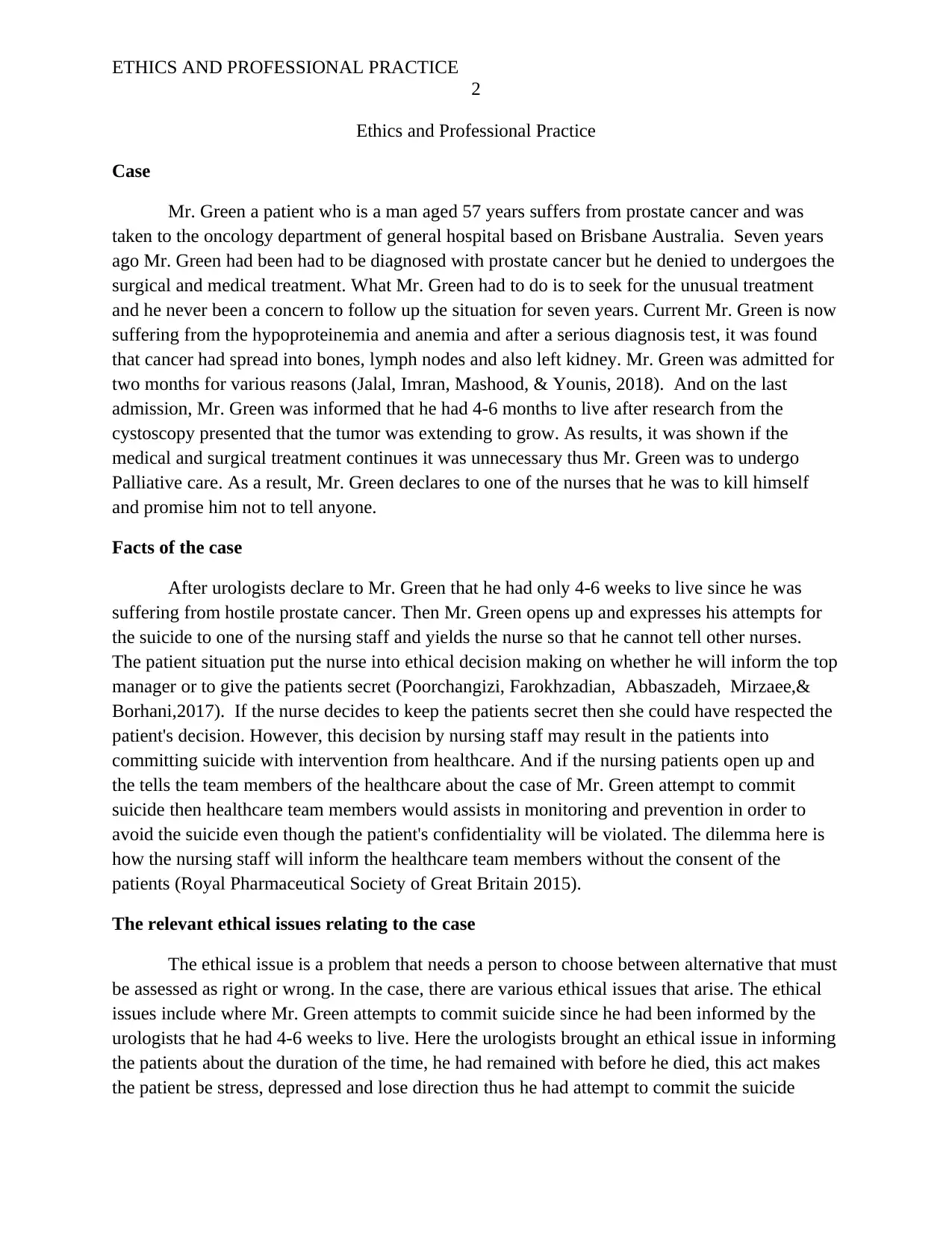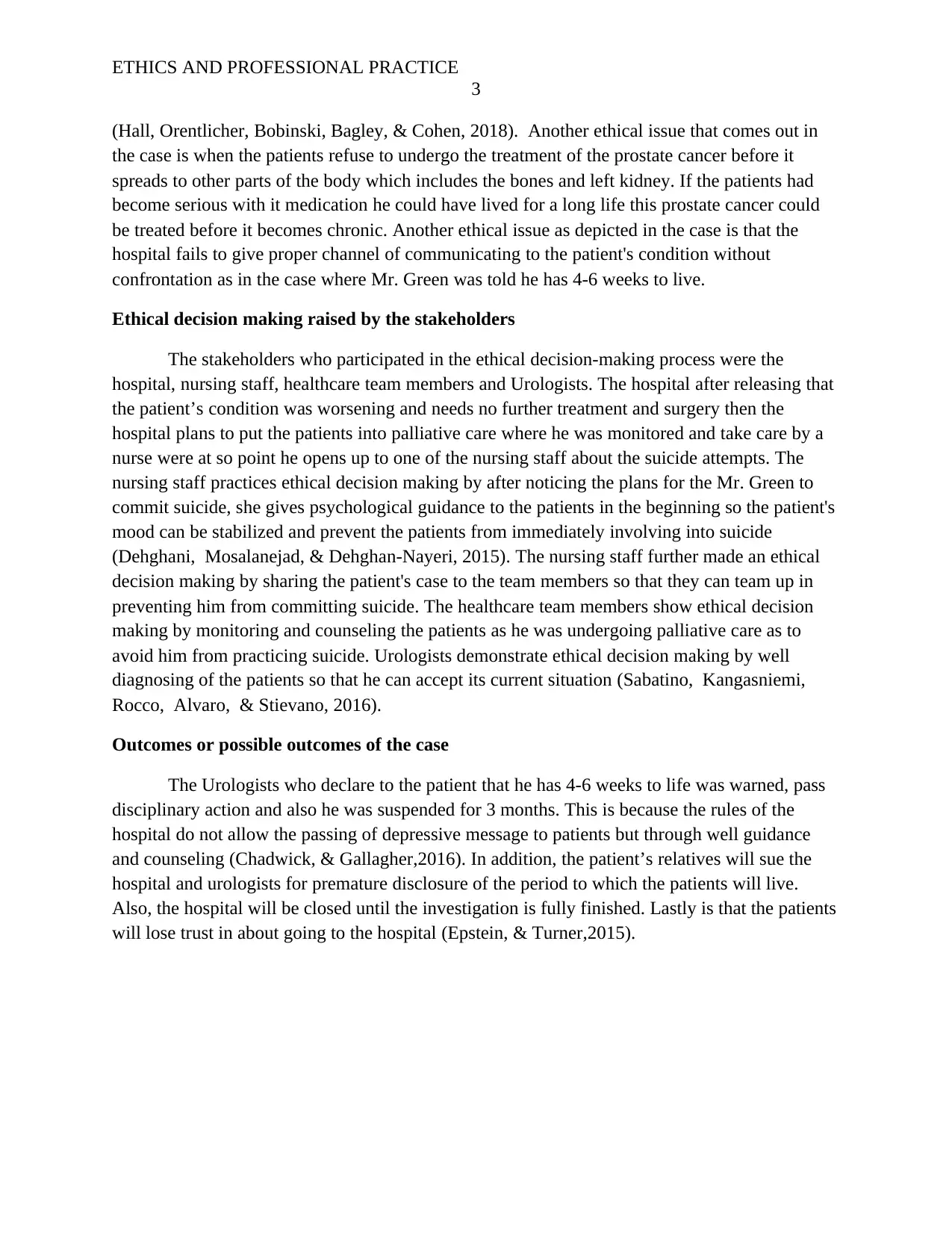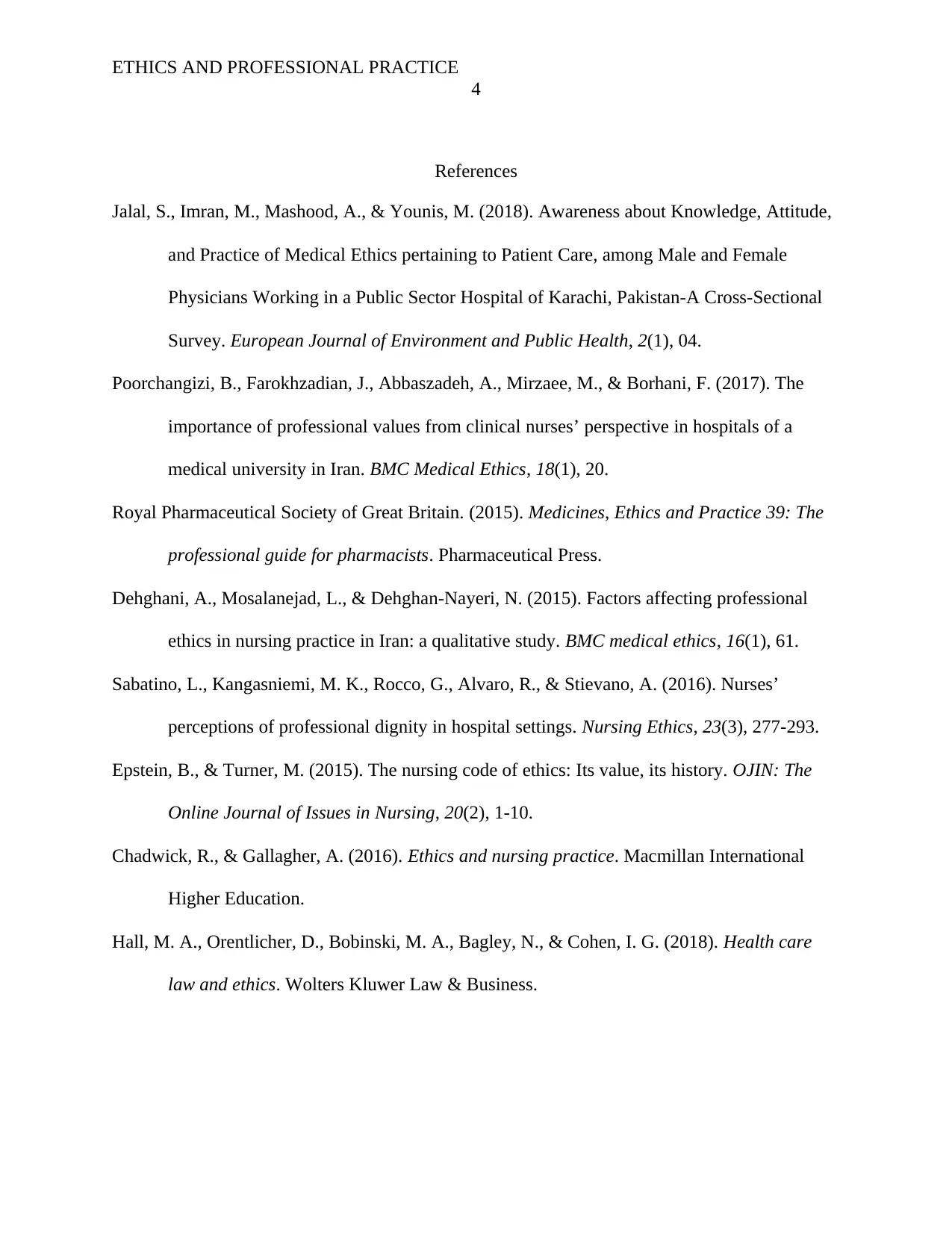Ethics & Professional Practice: Analysis of Mr. Green's Case (FLD201)
VerifiedAdded on 2023/03/30
|5
|1202
|74
Case Study
AI Summary
This case study examines the ethical complexities surrounding Mr. Green, a 57-year-old patient with prostate cancer who refuses treatment and later attempts suicide after being informed of his terminal condition. The case explores various ethical issues, including patient autonomy, informed consent, the duty to warn, and the challenges of palliative care. Stakeholders involved include the hospital, nursing staff, healthcare team, and urologists, each facing ethical decision-making dilemmas. The analysis discusses potential outcomes, such as legal repercussions, professional disciplinary actions, and the erosion of patient trust. The case highlights the importance of ethical communication, patient support, and the need for healthcare professionals to balance patient confidentiality with the duty to protect vulnerable individuals. The study uses relevant literature to support its arguments.

Running head: ETHICS AND PROFESSIONAL PRACTICE
1
Ethics and professional practice:
Name:
Institution:
1
Ethics and professional practice:
Name:
Institution:
Paraphrase This Document
Need a fresh take? Get an instant paraphrase of this document with our AI Paraphraser

ETHICS AND PROFESSIONAL PRACTICE
2
Ethics and Professional Practice
Case
Mr. Green a patient who is a man aged 57 years suffers from prostate cancer and was
taken to the oncology department of general hospital based on Brisbane Australia. Seven years
ago Mr. Green had been had to be diagnosed with prostate cancer but he denied to undergoes the
surgical and medical treatment. What Mr. Green had to do is to seek for the unusual treatment
and he never been a concern to follow up the situation for seven years. Current Mr. Green is now
suffering from the hypoproteinemia and anemia and after a serious diagnosis test, it was found
that cancer had spread into bones, lymph nodes and also left kidney. Mr. Green was admitted for
two months for various reasons (Jalal, Imran, Mashood, & Younis, 2018). And on the last
admission, Mr. Green was informed that he had 4-6 months to live after research from the
cystoscopy presented that the tumor was extending to grow. As results, it was shown if the
medical and surgical treatment continues it was unnecessary thus Mr. Green was to undergo
Palliative care. As a result, Mr. Green declares to one of the nurses that he was to kill himself
and promise him not to tell anyone.
Facts of the case
After urologists declare to Mr. Green that he had only 4-6 weeks to live since he was
suffering from hostile prostate cancer. Then Mr. Green opens up and expresses his attempts for
the suicide to one of the nursing staff and yields the nurse so that he cannot tell other nurses.
The patient situation put the nurse into ethical decision making on whether he will inform the top
manager or to give the patients secret (Poorchangizi, Farokhzadian, Abbaszadeh, Mirzaee,&
Borhani,2017). If the nurse decides to keep the patients secret then she could have respected the
patient's decision. However, this decision by nursing staff may result in the patients into
committing suicide with intervention from healthcare. And if the nursing patients open up and
the tells the team members of the healthcare about the case of Mr. Green attempt to commit
suicide then healthcare team members would assists in monitoring and prevention in order to
avoid the suicide even though the patient's confidentiality will be violated. The dilemma here is
how the nursing staff will inform the healthcare team members without the consent of the
patients (Royal Pharmaceutical Society of Great Britain 2015).
The relevant ethical issues relating to the case
The ethical issue is a problem that needs a person to choose between alternative that must
be assessed as right or wrong. In the case, there are various ethical issues that arise. The ethical
issues include where Mr. Green attempts to commit suicide since he had been informed by the
urologists that he had 4-6 weeks to live. Here the urologists brought an ethical issue in informing
the patients about the duration of the time, he had remained with before he died, this act makes
the patient be stress, depressed and lose direction thus he had attempt to commit the suicide
2
Ethics and Professional Practice
Case
Mr. Green a patient who is a man aged 57 years suffers from prostate cancer and was
taken to the oncology department of general hospital based on Brisbane Australia. Seven years
ago Mr. Green had been had to be diagnosed with prostate cancer but he denied to undergoes the
surgical and medical treatment. What Mr. Green had to do is to seek for the unusual treatment
and he never been a concern to follow up the situation for seven years. Current Mr. Green is now
suffering from the hypoproteinemia and anemia and after a serious diagnosis test, it was found
that cancer had spread into bones, lymph nodes and also left kidney. Mr. Green was admitted for
two months for various reasons (Jalal, Imran, Mashood, & Younis, 2018). And on the last
admission, Mr. Green was informed that he had 4-6 months to live after research from the
cystoscopy presented that the tumor was extending to grow. As results, it was shown if the
medical and surgical treatment continues it was unnecessary thus Mr. Green was to undergo
Palliative care. As a result, Mr. Green declares to one of the nurses that he was to kill himself
and promise him not to tell anyone.
Facts of the case
After urologists declare to Mr. Green that he had only 4-6 weeks to live since he was
suffering from hostile prostate cancer. Then Mr. Green opens up and expresses his attempts for
the suicide to one of the nursing staff and yields the nurse so that he cannot tell other nurses.
The patient situation put the nurse into ethical decision making on whether he will inform the top
manager or to give the patients secret (Poorchangizi, Farokhzadian, Abbaszadeh, Mirzaee,&
Borhani,2017). If the nurse decides to keep the patients secret then she could have respected the
patient's decision. However, this decision by nursing staff may result in the patients into
committing suicide with intervention from healthcare. And if the nursing patients open up and
the tells the team members of the healthcare about the case of Mr. Green attempt to commit
suicide then healthcare team members would assists in monitoring and prevention in order to
avoid the suicide even though the patient's confidentiality will be violated. The dilemma here is
how the nursing staff will inform the healthcare team members without the consent of the
patients (Royal Pharmaceutical Society of Great Britain 2015).
The relevant ethical issues relating to the case
The ethical issue is a problem that needs a person to choose between alternative that must
be assessed as right or wrong. In the case, there are various ethical issues that arise. The ethical
issues include where Mr. Green attempts to commit suicide since he had been informed by the
urologists that he had 4-6 weeks to live. Here the urologists brought an ethical issue in informing
the patients about the duration of the time, he had remained with before he died, this act makes
the patient be stress, depressed and lose direction thus he had attempt to commit the suicide

ETHICS AND PROFESSIONAL PRACTICE
3
(Hall, Orentlicher, Bobinski, Bagley, & Cohen, 2018). Another ethical issue that comes out in
the case is when the patients refuse to undergo the treatment of the prostate cancer before it
spreads to other parts of the body which includes the bones and left kidney. If the patients had
become serious with it medication he could have lived for a long life this prostate cancer could
be treated before it becomes chronic. Another ethical issue as depicted in the case is that the
hospital fails to give proper channel of communicating to the patient's condition without
confrontation as in the case where Mr. Green was told he has 4-6 weeks to live.
Ethical decision making raised by the stakeholders
The stakeholders who participated in the ethical decision-making process were the
hospital, nursing staff, healthcare team members and Urologists. The hospital after releasing that
the patient’s condition was worsening and needs no further treatment and surgery then the
hospital plans to put the patients into palliative care where he was monitored and take care by a
nurse were at so point he opens up to one of the nursing staff about the suicide attempts. The
nursing staff practices ethical decision making by after noticing the plans for the Mr. Green to
commit suicide, she gives psychological guidance to the patients in the beginning so the patient's
mood can be stabilized and prevent the patients from immediately involving into suicide
(Dehghani, Mosalanejad, & Dehghan-Nayeri, 2015). The nursing staff further made an ethical
decision making by sharing the patient's case to the team members so that they can team up in
preventing him from committing suicide. The healthcare team members show ethical decision
making by monitoring and counseling the patients as he was undergoing palliative care as to
avoid him from practicing suicide. Urologists demonstrate ethical decision making by well
diagnosing of the patients so that he can accept its current situation (Sabatino, Kangasniemi,
Rocco, Alvaro, & Stievano, 2016).
Outcomes or possible outcomes of the case
The Urologists who declare to the patient that he has 4-6 weeks to life was warned, pass
disciplinary action and also he was suspended for 3 months. This is because the rules of the
hospital do not allow the passing of depressive message to patients but through well guidance
and counseling (Chadwick, & Gallagher,2016). In addition, the patient’s relatives will sue the
hospital and urologists for premature disclosure of the period to which the patients will live.
Also, the hospital will be closed until the investigation is fully finished. Lastly is that the patients
will lose trust in about going to the hospital (Epstein, & Turner,2015).
3
(Hall, Orentlicher, Bobinski, Bagley, & Cohen, 2018). Another ethical issue that comes out in
the case is when the patients refuse to undergo the treatment of the prostate cancer before it
spreads to other parts of the body which includes the bones and left kidney. If the patients had
become serious with it medication he could have lived for a long life this prostate cancer could
be treated before it becomes chronic. Another ethical issue as depicted in the case is that the
hospital fails to give proper channel of communicating to the patient's condition without
confrontation as in the case where Mr. Green was told he has 4-6 weeks to live.
Ethical decision making raised by the stakeholders
The stakeholders who participated in the ethical decision-making process were the
hospital, nursing staff, healthcare team members and Urologists. The hospital after releasing that
the patient’s condition was worsening and needs no further treatment and surgery then the
hospital plans to put the patients into palliative care where he was monitored and take care by a
nurse were at so point he opens up to one of the nursing staff about the suicide attempts. The
nursing staff practices ethical decision making by after noticing the plans for the Mr. Green to
commit suicide, she gives psychological guidance to the patients in the beginning so the patient's
mood can be stabilized and prevent the patients from immediately involving into suicide
(Dehghani, Mosalanejad, & Dehghan-Nayeri, 2015). The nursing staff further made an ethical
decision making by sharing the patient's case to the team members so that they can team up in
preventing him from committing suicide. The healthcare team members show ethical decision
making by monitoring and counseling the patients as he was undergoing palliative care as to
avoid him from practicing suicide. Urologists demonstrate ethical decision making by well
diagnosing of the patients so that he can accept its current situation (Sabatino, Kangasniemi,
Rocco, Alvaro, & Stievano, 2016).
Outcomes or possible outcomes of the case
The Urologists who declare to the patient that he has 4-6 weeks to life was warned, pass
disciplinary action and also he was suspended for 3 months. This is because the rules of the
hospital do not allow the passing of depressive message to patients but through well guidance
and counseling (Chadwick, & Gallagher,2016). In addition, the patient’s relatives will sue the
hospital and urologists for premature disclosure of the period to which the patients will live.
Also, the hospital will be closed until the investigation is fully finished. Lastly is that the patients
will lose trust in about going to the hospital (Epstein, & Turner,2015).
⊘ This is a preview!⊘
Do you want full access?
Subscribe today to unlock all pages.

Trusted by 1+ million students worldwide

ETHICS AND PROFESSIONAL PRACTICE
4
References
Jalal, S., Imran, M., Mashood, A., & Younis, M. (2018). Awareness about Knowledge, Attitude,
and Practice of Medical Ethics pertaining to Patient Care, among Male and Female
Physicians Working in a Public Sector Hospital of Karachi, Pakistan-A Cross-Sectional
Survey. European Journal of Environment and Public Health, 2(1), 04.
Poorchangizi, B., Farokhzadian, J., Abbaszadeh, A., Mirzaee, M., & Borhani, F. (2017). The
importance of professional values from clinical nurses’ perspective in hospitals of a
medical university in Iran. BMC Medical Ethics, 18(1), 20.
Royal Pharmaceutical Society of Great Britain. (2015). Medicines, Ethics and Practice 39: The
professional guide for pharmacists. Pharmaceutical Press.
Dehghani, A., Mosalanejad, L., & Dehghan-Nayeri, N. (2015). Factors affecting professional
ethics in nursing practice in Iran: a qualitative study. BMC medical ethics, 16(1), 61.
Sabatino, L., Kangasniemi, M. K., Rocco, G., Alvaro, R., & Stievano, A. (2016). Nurses’
perceptions of professional dignity in hospital settings. Nursing Ethics, 23(3), 277-293.
Epstein, B., & Turner, M. (2015). The nursing code of ethics: Its value, its history. OJIN: The
Online Journal of Issues in Nursing, 20(2), 1-10.
Chadwick, R., & Gallagher, A. (2016). Ethics and nursing practice. Macmillan International
Higher Education.
Hall, M. A., Orentlicher, D., Bobinski, M. A., Bagley, N., & Cohen, I. G. (2018). Health care
law and ethics. Wolters Kluwer Law & Business.
4
References
Jalal, S., Imran, M., Mashood, A., & Younis, M. (2018). Awareness about Knowledge, Attitude,
and Practice of Medical Ethics pertaining to Patient Care, among Male and Female
Physicians Working in a Public Sector Hospital of Karachi, Pakistan-A Cross-Sectional
Survey. European Journal of Environment and Public Health, 2(1), 04.
Poorchangizi, B., Farokhzadian, J., Abbaszadeh, A., Mirzaee, M., & Borhani, F. (2017). The
importance of professional values from clinical nurses’ perspective in hospitals of a
medical university in Iran. BMC Medical Ethics, 18(1), 20.
Royal Pharmaceutical Society of Great Britain. (2015). Medicines, Ethics and Practice 39: The
professional guide for pharmacists. Pharmaceutical Press.
Dehghani, A., Mosalanejad, L., & Dehghan-Nayeri, N. (2015). Factors affecting professional
ethics in nursing practice in Iran: a qualitative study. BMC medical ethics, 16(1), 61.
Sabatino, L., Kangasniemi, M. K., Rocco, G., Alvaro, R., & Stievano, A. (2016). Nurses’
perceptions of professional dignity in hospital settings. Nursing Ethics, 23(3), 277-293.
Epstein, B., & Turner, M. (2015). The nursing code of ethics: Its value, its history. OJIN: The
Online Journal of Issues in Nursing, 20(2), 1-10.
Chadwick, R., & Gallagher, A. (2016). Ethics and nursing practice. Macmillan International
Higher Education.
Hall, M. A., Orentlicher, D., Bobinski, M. A., Bagley, N., & Cohen, I. G. (2018). Health care
law and ethics. Wolters Kluwer Law & Business.
Paraphrase This Document
Need a fresh take? Get an instant paraphrase of this document with our AI Paraphraser

ETHICS AND PROFESSIONAL PRACTICE
5
5
1 out of 5
Related Documents
Your All-in-One AI-Powered Toolkit for Academic Success.
+13062052269
info@desklib.com
Available 24*7 on WhatsApp / Email
![[object Object]](/_next/static/media/star-bottom.7253800d.svg)
Unlock your academic potential
Copyright © 2020–2025 A2Z Services. All Rights Reserved. Developed and managed by ZUCOL.





